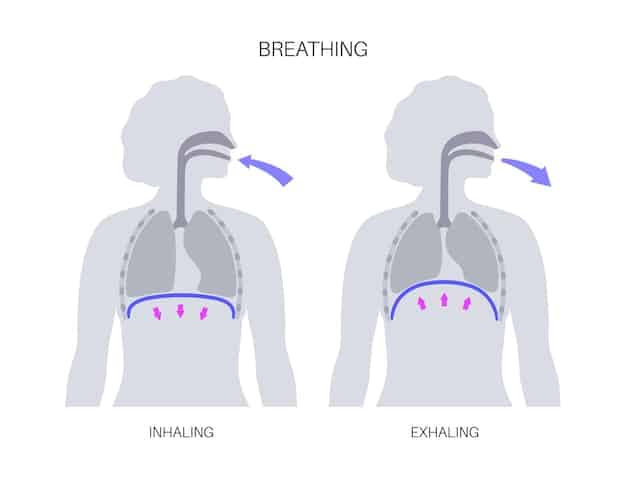The Science of Breathing: Calm Nerves in 5 Minutes

The Science of Breathing: How 5 Minutes of Diaphragmatic Breathing Can Calm Your Nerves explores how controlled breathing techniques, particularly diaphragmatic breathing, can activate the parasympathetic nervous system, reducing stress and promoting relaxation.
Feeling overwhelmed? Discover The Science of Breathing: How 5 Minutes of Diaphragmatic Breathing Can Calm Your Nerves, a simple yet powerful technique to manage stress and regain control of your emotional state.
The Autonomic Nervous System and Stress
Understanding how stress impacts your body is crucial to appreciate the effectiveness of diaphragmatic breathing. Your autonomic nervous system, responsible for involuntary functions, plays a vital role here. Let’s explore how.
The Sympathetic and Parasympathetic Branches
The autonomic nervous system has two main branches: the sympathetic nervous system (SNS) and the parasympathetic nervous system (PNS). The SNS activates during stress, while the PNS promotes relaxation.
How Stress Activates the SNS
When you perceive a threat, the SNS kicks in, triggering the “fight or flight” response. This involves releasing stress hormones like cortisol and adrenaline, increasing heart rate and blood pressure.
- The sympathetic nervous system is responsible for activating the body’s stress response.
- Hormones like cortisol and adrenaline are released during stressful situations.
- Increased heart rate and blood pressure are common physiological responses to stress.
Stress hormones flood your system, preparing you to either face the threat head-on or flee to safety. While this response is essential for survival in immediate danger, chronic activation can lead to health problems.
Diaphragmatic Breathing: Your Natural Calming Tool
Diaphragmatic breathing, also known as belly breathing, is a technique that uses the diaphragm muscle to deepen breathing. It’s a powerful tool for activating the PNS and calming the nervous system. Let’s delve into how it works.

Engaging the Diaphragm
Unlike shallow chest breathing, diaphragmatic breathing involves fully engaging the diaphragm. This large muscle at the base of your lungs is responsible for efficient breathing.
The Mechanics of Belly Breathing
During inhalation, the diaphragm contracts and moves downward, creating more space for the lungs to expand. This causes your abdomen to rise. During exhalation, the diaphragm relaxes, and the abdomen falls.
- Diaphragmatic breathing involves consciously engaging the diaphragm muscle.
- During inhalation, the diaphragm contracts, allowing the lungs to expand fully.
- The abdomen rises during inhalation and falls during exhalation in diaphragmatic breathing.
By using your diaphragm effectively, you take deeper breaths, which stimulate the vagus nerve, a key component of the PNS. This stimulation helps to counteract the effects of the SNS.
The Vagus Nerve and the Relaxation Response
The vagus nerve is a long, meandering nerve that connects the brain to many organs, including the heart and digestive system. Its role is crucial in activating the relaxation response. Keep reading to find out more.
The Vagus Nerve’s Role
The vagus nerve plays a critical role in regulating heart rate, digestion, and immune function. Stimulating this nerve activates the PNS, promoting relaxation and reducing stress.
How Diaphragmatic Breathing Stimulates the Vagus Nerve
Deep, slow diaphragmatic breathing directly stimulates the vagus nerve. This stimulation sends signals to the brain that promote relaxation and reduce anxiety.
- The vagus nerve connects the brain to various organs, influencing heart rate and digestion.
- Stimulation of the vagus nerve activates the parasympathetic nervous system.
- Deep breathing techniques, like diaphragmatic breathing, stimulate the vagus nerve.
When the vagus nerve is stimulated, it releases neurotransmitters like acetylcholine, which slow down heart rate and lower blood pressure. This helps to shift the body from a state of stress to a state of calm.
Step-by-Step Guide to Diaphragmatic Breathing
Ready to start practicing diaphragmatic breathing? Here’s a simple step-by-step guide to help you get started. Follow these instructions carefully for optimal results.
Finding a Comfortable Position
Start by finding a comfortable position, either lying down or sitting in a chair. Make sure your back is supported and your shoulders are relaxed.
The Breathing Technique
Place one hand on your chest and the other on your abdomen. Breathe in slowly through your nose, allowing your abdomen to rise while keeping your chest relatively still. Exhale slowly through your mouth, gently pressing on your abdomen to release all the air.

- Lie down or sit comfortably with your back supported.
- Place one hand on your chest and the other on your abdomen.
- Inhale slowly through your nose, allowing your abdomen to rise.
- Exhale slowly through your mouth, gently pressing on your abdomen.
Repeat this process for 5 to 10 minutes, focusing on your breath and noticing the rise and fall of your abdomen.. With consistent practice, diaphragmatic breathing can become a natural and automatic response to stress.
Integrating Diaphragmatic Breathing into Your Daily Life
Making diaphragmatic breathing a regular part of your routine is key to experiencing its long-term benefits. You can use it as a preventive measure or as an immediate stress-relief technique. Read along to discover some practical techniques.
Using Diaphragmatic Breathing Preventively
Schedule a few minutes each day to practice diaphragmatic breathing, even when you’re not feeling stressed. This can help to build resilience and prepare your nervous system to handle future stressors.
Using Diaphragmatic Breathing for Immediate Relief
When you feel anxiety rising, take a few minutes to practice diaphragmatic breathing. It can quickly calm your nerves and help you regain control of your emotions.
- Schedule daily practice sessions to build resilience and prepare your nervous system.
- Use diaphragmatic breathing as an immediate stress-relief technique when anxiety arises.
- Combine diaphragmatic breathing with other relaxation techniques for enhanced stress management.
Diaphragmatic breathing can be easily combined with other relaxation techniques, such as meditation or progressive muscle relaxation, for enhanced effectiveness. The key is to find what works best for you and to make it a consistent practice.
The Long-Term Benefits of Consistent Practice
Consistent practice of diaphragmatic breathing can lead to numerous long-term benefits for both physical and mental health. Regular use can lead to major strides.
Reduced Stress and Anxiety
By regularly activating the PNS, diaphragmatic breathing can help to reduce overall levels of stress and anxiety. This can lead to improvements in mood, sleep, and overall well-being.
Improved Physical Health
Diaphragmatic breathing has been shown to lower blood pressure, improve heart rate variability, and enhance immune function. It can also help to alleviate symptoms of certain respiratory conditions.
- Regular practice of diaphragmatic breathing leads to reduced levels of stress and anxiety.
- Improved physical health, including lower blood pressure and enhanced immune function, is a long-term benefit.
- Consistent practice promotes overall well-being and resilience to future stressors.
Incorporating diaphragmatic breathing into your daily routine can lead to significant improvements in your overall health and quality of life. It’s a simple, accessible, and effective tool for managing stress and promoting well-being in the face of daily challenges and stressors.
| Key Point | Brief Description |
|---|---|
| 🧘 Diaphragmatic Breathing | Deep breathing technique to engage the diaphragm. |
| 🧠 Autonomic Nervous System | Controls involuntary functions, with sympathetic and parasympathetic branches. |
| 🌿 Vagus Nerve | Stimulation activates the relaxation response. |
| 💪 Long-Term Benefits | Reduced stress, improved physical health, resilience. |
Frequently Asked Questions
▼
You can practice diaphragmatic breathing multiple times a day. Aim for at least one or two sessions, each lasting 5-10 minutes, for the best results. Consistency is key.
▼
Yes, diaphragmatic breathing can be a valuable tool during panic attacks. It helps activate the parasympathetic nervous system, reducing the intensity of the attack.
▼
Generally, diaphragmatic breathing is safe. However, if you have underlying respiratory or cardiovascular conditions, consult your doctor before starting to practice it regularly.
▼
While you might feel a slight calming effect immediately, the full benefits of diaphragmatic breathing are typically experienced with consistent practice over time.
▼
Yes, diaphragmatic breathing can be done virtually anywhere. Find a quiet, comfortable space, whether you’re at home, at work, or even traveling, to practice effectively.
Conclusion
In conclusion, The Science of Breathing: How 5 Minutes of Diaphragmatic Breathing Can Calm Your Nerves provides a practical, effective way to manage stress and promote overall well-being. By understanding how this technique stimulates the vagus nerve and activates the parasympathetic nervous system, individuals can harness the power of their breath to regain control and calm their nerves anytime, anywhere.





